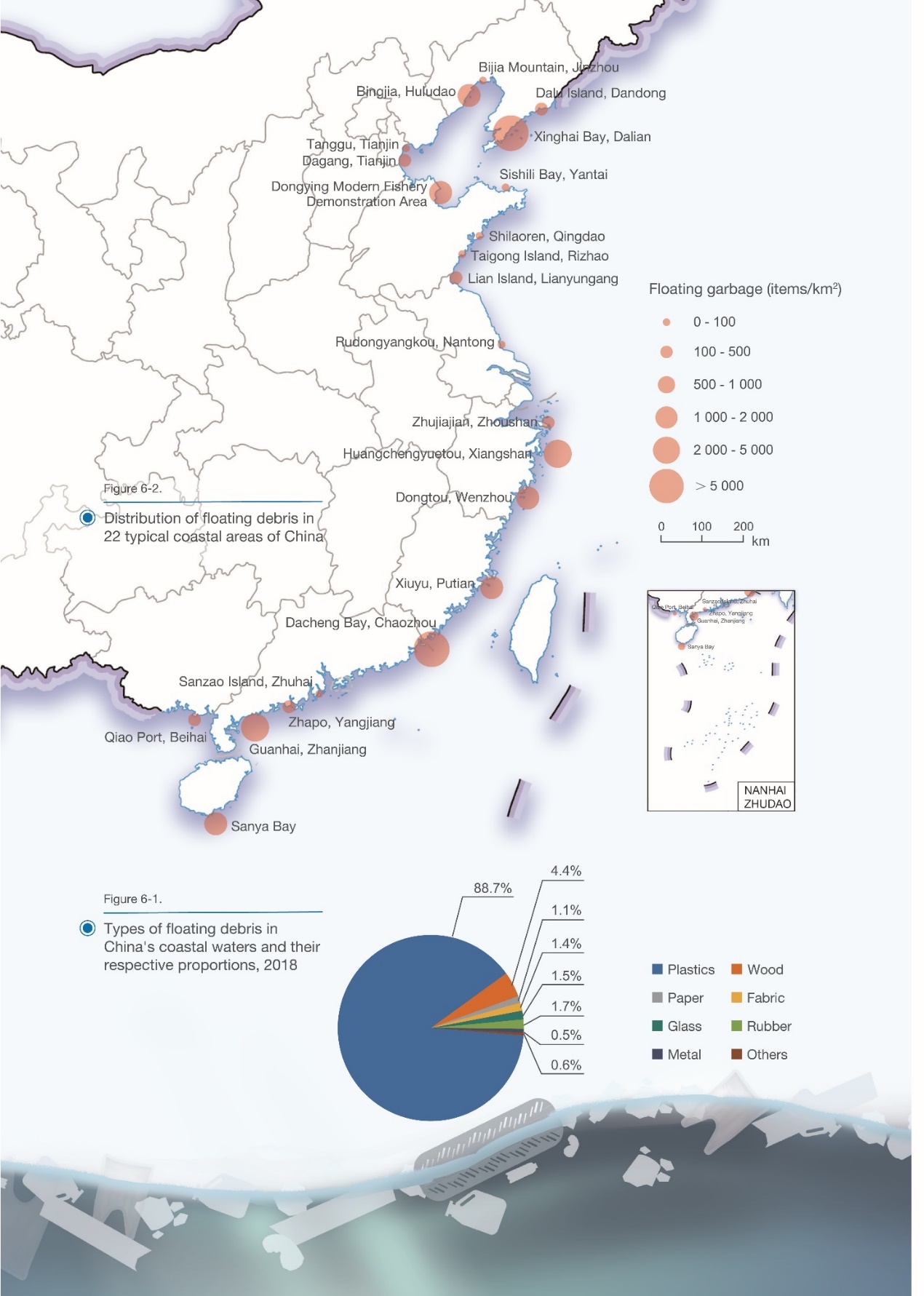Analysis of the distribution and variation of marine debris and microplastics in China's coastal waters(2020)
Target 14.1: By 2025, prevent and significantly reduce marine pollution of all kinds, particularly from activities, including marine debris and nutrient pollution.
| Highlights |
| An analysis of the distribution and variation of floating debris in 22 typical coastal areas of China showed that the abundance of floating debris in China's coastal waters in 2018 was approximately 25% below the 2010 to 2014 average. Microplastics shape found in China's coastal waters in 2019 were mainly fibrous, linear, spherical, and fragmented and the distribution of microplastics varied from region to region, with the average abundance of microplastics at low to medium levels. |
Background
In recent years, marine debris and microplastics, being a major cause of environmental woes, have gained greater attention as a major concern to various constituencies. Today, work in this area is moving beyond research to tangible actions of pollution control and joint global endeavors. Reducing plastic debris is one of the key indicators of marine pollution control in the framework of UN 2030 Agenda for Sustainable Development. However, it remains a Tier II indicator to this day because of a dearth of data on this phenomenon at the international level. The competent authorities and research institutions in China have been working hard on monitoring and analysis, delivering a range of outcomes.
Data used
◎ Data on marine microplastics used in this study primarily from monitoring of microplastics in China's coastal waters by the Ministry of Natural Resources and the Bulletin on the State of China's Marine Ecological Environment 2019 published by the Ministry of Ecology and Environment.
◎ Marine floating debris data primarily from the Bulletin on the State of China's Marine Ecological Environment 2018 published by the Ministry of Ecology and Environment and relevant papers published in international journals.
Method
This study aims to map the current state of pollution by marine debris and microplastics in China's coastal waters and the distribution of same by region by consolidating the available mapping data, data from marine bulletins and data from academic literature on marine debris and microplastics in the said waters, with an analysis of the trends of variation in respect of these pollutants against historical data.
Results and analysis
1) Distribution and change of floating debris in China's coastal waters
According to the monitoring data, the abundance of floating debris in China's coastal waters has been on a decline since 2015. The abundance of floating debris in 2018 was approximately 25% lower than the average of 3 207 pieces/km2 recorded for the period 2010-2014 (Zhou et al., 2016).
In 2018, most of the floating debris in China's coastal waters was plastic waste (88.7%), followed by wood (4.4%) (Fig. 6-1). The plastic waste identified was mostly polystyrene foam, plastic bags and plastic bottles.
A study of the distribution of floating debris in 22 typical coastal areas of China identified significant variations in the abundance of floating debris in different areas (Fig. 6-2), the highest abundance found in: Xinghai Bay, Dalian, Liaoning province; Yuetou Bay, Huangcheng, Xiangshan, Zhejiang province; Dacheng Bay, Chaozhou, Guangdong province; and Guanhai Bay, Zhanjiang, Guangdong province.
2) Distribution patterns of microplastics in China's coastal waters
A study of the distribution of microplastics in China's coastal waters in 2019 in terms of shape, color, size and polymer type finds: (a) that most of the microplastics was in the form of fibers, threads, pellets/granules and fragments; (b) that the highest proportion of microplastics found was 1.0-2.0 mm in size; (c) that the microplastics came in eight colors, namely, white, black, red, yellow, blue, green, purple and transparent, with a different mix of colors in each of the sample areas; and (d) that the predominant types of microplastics were Polyethylene Terephthalate (PET), Polystyrene (PS), Polyethylene (PE) and Rayon.
Monitoring of the abundance of microplastics in China's coastal waters in 2019 showed that the abundance of microplastics floating on the surface in the section of the Bohai Sea monitored was 0.82 items/m3 and in the section of the East China Sea monitored, 0.25 items/m3, with the average abundance of microplastics at low to medium levels.
Outlook
Reducing marine debris and microplastics pollution is one of the priorities on the agenda of global ocean governance, which requires all countries to work together. The current gaps in the scientific knowledge of marine microplastics pollution make it necessary to better analyze the impacts of marine microplastics on environmental pollution in the future. While pollution by marine debris and microplastics in China's coastal waters has been declining, much remains to be done to tackle marine debris and microplastics in the marine environment with more conclusive solutions. Dynamic monitoring of plastic waste and microplastics in coastal waters should be continued and a database built, along with studies on the distribution of microplastics in the oceanic and polar environments, to provide a scientific basis for the management of marine debris and microplastics at the global level.


